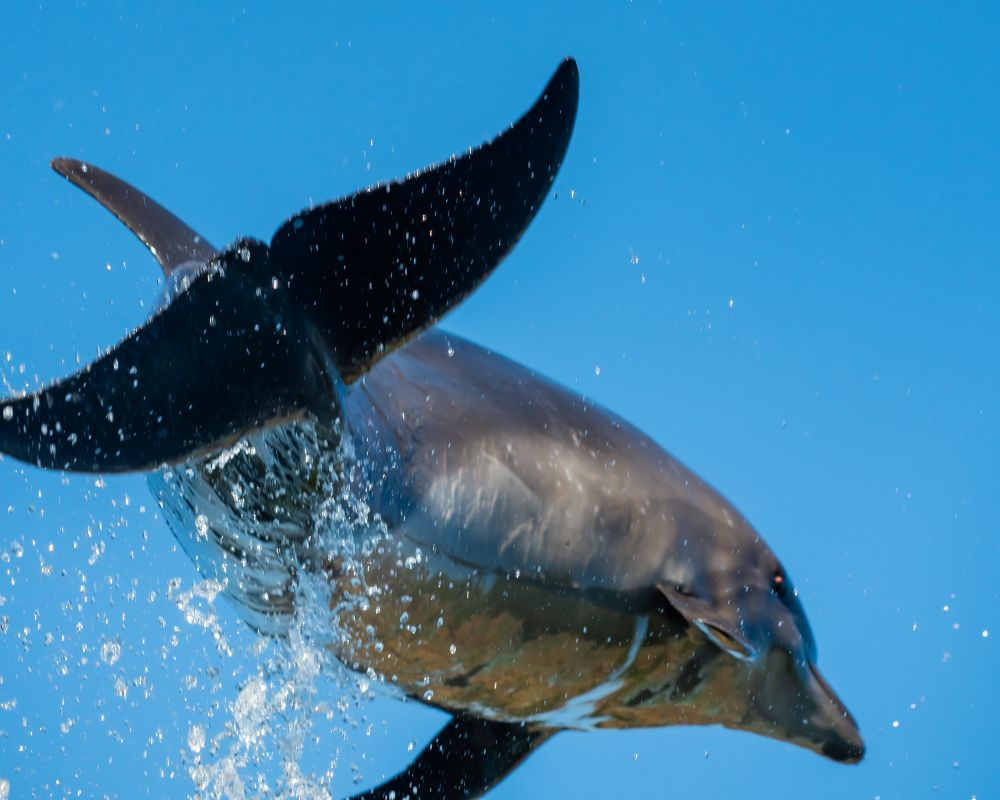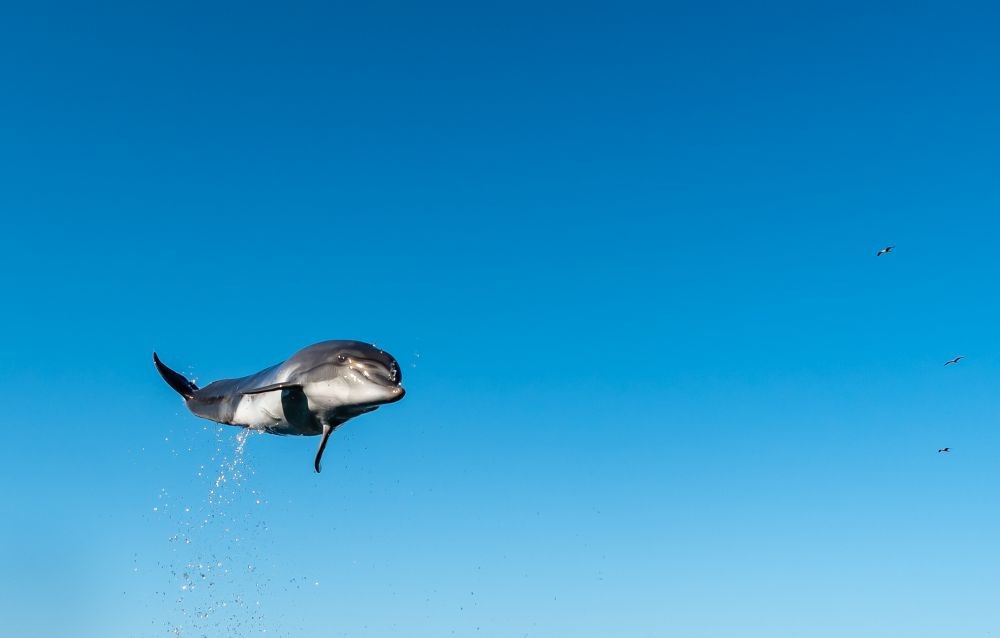
Andrey Abramov, head of the Utrish Marine Station of the A. N. Severtsov Institute of Ecology and Evolution of the Russian Academy of Sciences, told the magazine "Science and Life" about how dolphins sleep, how many kilometers they swim per day, whether they save drowning people, and why they might not like your manicure.
— Andrey Valerievich, when did you start working at the marine station?
— For me, it all started in 1983. At that time, I was a student at the biology department of Moscow State University, the department of zoology and comparative anatomy of vertebrates. And the head of the department was academician Vladimir Evgenievich Sokolov, he was also the director of the Institute of Ecology and Evolution. At that time, it was called the Institute of Evolutionary Morphology and Ecology of Animals of the USSR Academy of Sciences, which included the Utrish marine station. That was when I was invited to work here. Here it was necessary to perform a certain amount of specific diving work, and by that time I had finished my service in the military dolphinarium of the USSR Ministry of Defense, after which I worked there for two years under a contract. So this work was close to me, and I was useful here.
— Military dolphinarium – what is it?
— It is a message to use marine animals for the needs of the Ministry of Defense. One day, people noticed the unique features of dolphins: adaptation to an aquatic lifestyle, deep-sea diving, fast swimming. And they thought – is it possible to use dolphins and pinnipeds for specific tasks?
— To dive to a submarine, for example?
— Nothing of the sort. This is fiction. But a dolphin can do quite a lot. First of all, attention was drawn to the ability of dolphins to navigate underwater, find each other using echolocator, and identify obstacles. These capabilities can be used to search for some objects underwater. Or the hydrodynamic capabilities of fast swimming, the physiology of deep-sea diving and surfacing without decompression - all this aroused great interest. If it is problematic for us to dive 100 meters even with the use of diving equipment, then for a dolphin it is 2.5 minutes there and back without any decompression, easily. They decided to study and use these features of adaptation to an aquatic lifestyle.
— When you came here in 1983, what was here?
— The biological station had already existed at this place for six years. It was a very well-organized field camp, there were tents and small houses, minimal pools for keeping dolphins and pinnipeds. There was an organized Black Sea expedition of the institute, which worked here seasonally - in the spring, employees arrived, animals were brought in. At the end of the season, in the fall, the employees left. Animals were released into the sea, sometimes died as a result of experiments, it was like that then, or were transferred to organizations cooperating with the institute, to live in captivity all year round.
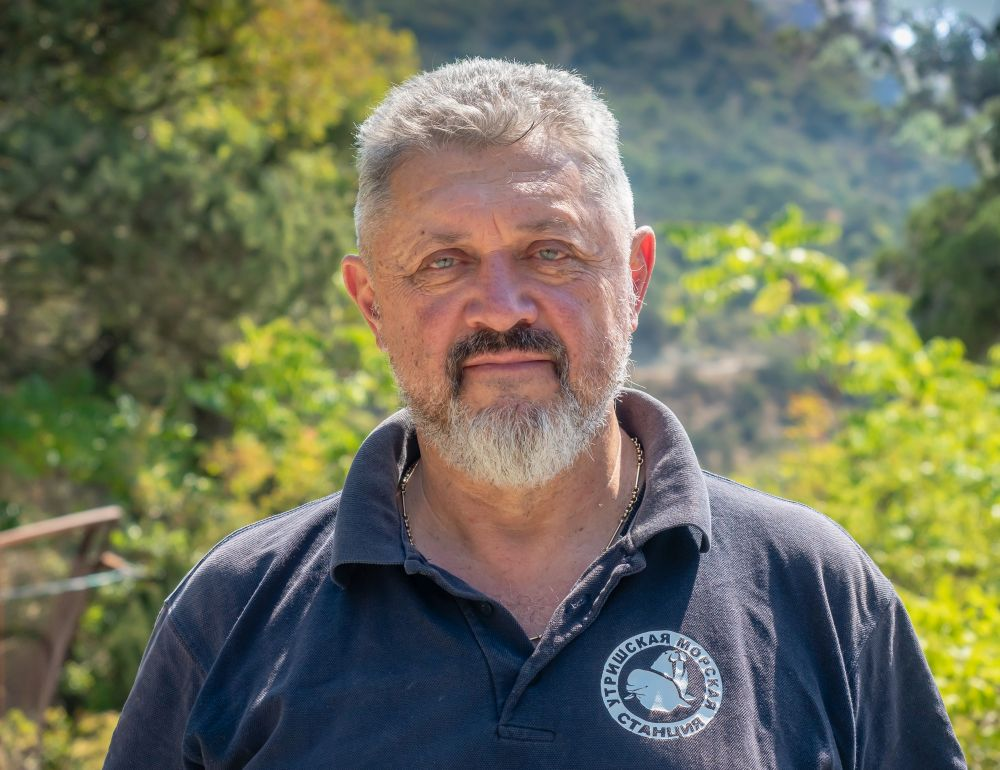
— It so happened that when I arrived, we began organizing year-round maintenance of marine animals. It was necessary to constantly conduct research on the animals that we had already worked on the year before, to continue experiments, and not release them or hand them over to someone else. It was necessary to improve the methods. And for year-round maintenance, it is important that the personnel live here year-round. They need to eat, create living conditions. And then we decided: no families, unless the employee works in the conditions of the Utrish Marine Station for six months. After this period of work, the employee has the right to bring his wife and children here and somehow settle in. So we had a certain number of local employees whose children were taken to the Novorossiysk boarding school for a week by the biological station's cars, and on weekends the children were brought here, to their parents. That's how we started working.
— Surely it was difficult in the everyday sense?
— We didn’t pay much attention to everyday life back then. We were young, everyday life came second, and dolphins came first. This is a unique site for keeping animals, and two kilometers away there was the second territory of the biological station, Lake Solenoe. This is a sea lagoon, where semi-free keeping of animals in sea enclosures was supported. Unfortunately, in severe winters this water area of 3.5 hectares and 5 meters deep with sea water freezes, but cold-resistant species, for example, belugas, are kept there all year round. If in summer the water temperature can reach 28 degrees, and the belugas can withstand it, then in winter, when the water freezes, the belugas break the ice.
— Why was this place chosen?
— This site was not chosen by chance – minimal anthropogenic impact, clean sea water, no one interfered with the work. Yes, we had to transport food, fish for the animals, medicine, but this remoteness allowed us to exist well and peacefully.
— What kind of scientific research has been conducted over the years?
— Discoveries of global significance have been made here. First of all, these are works related to the sleep of marine animals, echolocation, and sensory systems. These are works that allow us to extend the life of marine animals in captivity. It is known that animals in such conditions live longer than in the wild. For some reason, many people think that dolphins in the sea are healthy, and when they get to the dolphinarium, they start to get sick. In fact, everything is exactly the opposite.
— What diseases do they have in the wild?
— Any. First of all, these are helminthic invasions, pneumonia, skin lesions. If an animal has veterinary and medical care, normal nutrition, high-quality water, and proper care, then why shouldn't they live? They don't have to travel kilometers to catch fish. All the fish they are fed is checked - there are no parasites, the expiration dates and quality are observed. These animals are tested regularly, once a month or a quarter. We conduct a full diagnostic of white and red blood, see how the animal feels, make adjustments to the diet, to the conditions of maintenance.
- But all this had to be discovered! When we did not know all this, the life expectancy of dolphins in artificial conditions was very low. In the USSR, there were laws prohibiting at the legislative level feeding fish that went to the table of the country's residents to animals. We could not go and officially buy mullet or mackerel for dolphins. We fed horse mackerel or small fish of the third group - this is called a monoration. We did not know what vitamins to add and whether it was necessary to add them at all. We did not know how to defrost fish correctly. We made such mistakes that now give you goosebumps.
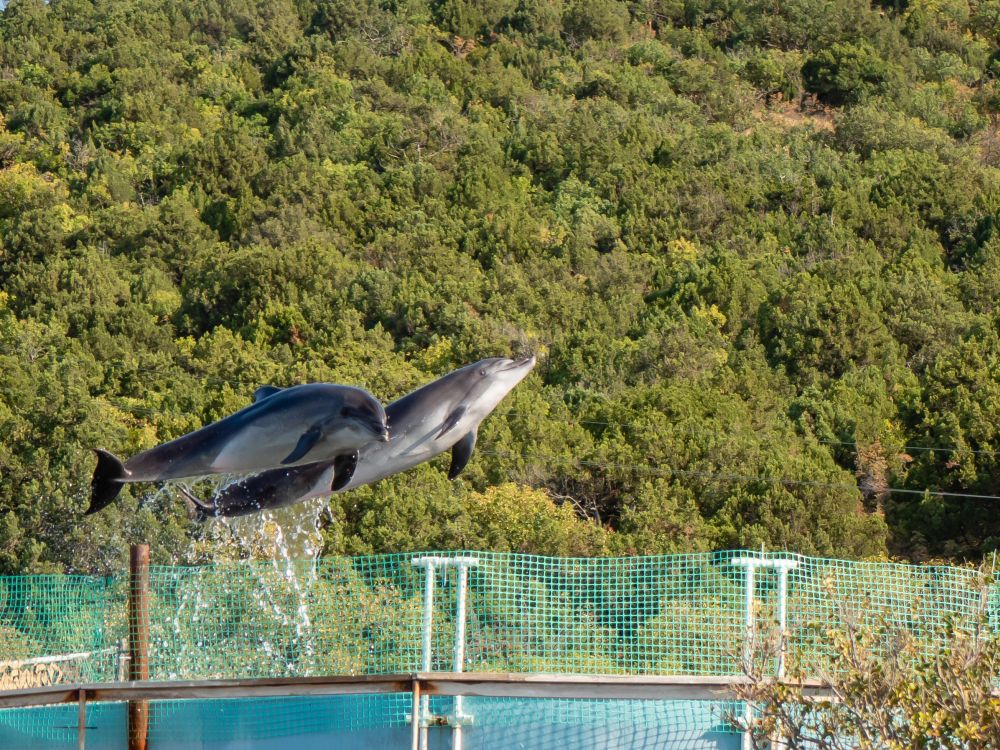
- But we put all this in order. From a certain time, when the "iron curtain" fell and we had the opportunity to travel abroad, we gained access to scientific literature and research by our colleagues, and learned many interesting things. It turned out that in many ways we "reinvented the wheel" and followed a parallel course with our foreign colleagues. In some things they succeeded, and in others - we did. All this gave some impetus - both in the maintenance of animals, and in their training and preparation. Over all these years, scientists from all over the world have visited here - from Canada, the USA, Pakistan, South Africa, Israel, China. Who hasn't been here!
- And why did they come here?
- In some countries, work related to fundamental research on animals is prohibited. Previously, in the USA, in order to catch dolphins, it was necessary to obtain permission from Congress. For a while they gave them, then they stopped. And the Americans faced a problem. The activists thought that all dolphinariums would close, but they did not because the Americans learned to obtain offspring in artificial conditions, they became pioneers in this field. We also know how to do this now, but for now in a natural way. Our next step will be to obtain offspring using IVF. We are moving towards this. But this is a big and very serious job.
— Where did you get dolphins before that?
— Academician Vladimir Evgenievich Sokolov, the director of the Institute, set the task: to come up with our own institute method for catching dolphins in the Black Sea. Usually, they used the fishing method for this, which has been preserved since the times of dolphin fishing. Everyone knows that dolphin fishing existed until 1966, when the Black Sea countries, except Turkey, signed the Convention and stopped catching dolphins for industrial purposes. The Turks joined in the late 80s. And then the task was set - to learn how to catch Black Sea dolphins here. By that time, we understood what the problem was, how the animal is injured during catching, how quantity kills quality, how we lose control if we get a large number of animals and we cannot keep track of them all - why they get caught in the net, why they choke. We managed to find out how the Americans catch dolphins in Florida. We couldn’t go ourselves, but we got the information. It remains to find a place on the Black Sea coast of the USSR from Romania to Turkey, closely similar in conditions. This place should be frequently visited by dolphins, they should go there every day; it should have appropriate depths, and this place should be close to the Utrish marine station, so that from the place of capture it is not far to transport them to the place of keeping.
— Where is this place?
— We found one. It is the Taman Bay of the Black Sea, the entrance to the Kerch Strait. There are a lot of fish, a lot of dolphins. The only problem is that this bay can freeze in winter. From spring to late autumn, this water area is visited by dolphins and is unofficially a "dolphin maternity hospital" because it is shallow, the water is always warm, and there is minimal anthropogenic impact. We did not think then that the Crimean Bridge would be built there. From 1985 to 2005, in this area, with permission from government agencies of the USSR and the Russian Federation, we caught dolphins every year. I received an author's certificate, it is in the Institute. It is called "Method of catching small cetaceans with light sweeping nets."
— And now you can't fish there because of the built Crimean Bridge?
— They didn't go anywhere because their grandmothers and great-grandmothers and great-grandfathers lived there, it's in their genetic memory. There was noise during the construction of the bridge, fish avoided the area, dolphins too. Now everything has calmed down — there are plenty of dolphins. But in 2005, the capture was stopped. For some reason, the Ministry of Natural Resources stopped issuing permits. But by that time we had already established births in artificial conditions, and we don't need capture.
— What is the life of the Utrish Marine Station like today?
— It is different from what it was before. In the distant 80s, the director of the institute, academician Vladimir Evgenievich Sokolov, and his deputy Lev Mukharamovich Mukhametov came up with an interesting scheme - to use dolphins not only for study, but also for demonstration. At that time, the USSR had only one dolphinarium in Batumi, and there were no demonstration dolphinariums in the Russian Federation. And so they came up with the idea of using the water area on Utrish, on Lake Solyonoe, to show dolphins for money to Soviet citizens. They charged 50 kopeikas for one viewing, and they finished when the ticket price was one ruble. They planned to use this money for the development of the biological station and scientific research. If you keep marine mammals, the costs are gigantic. And you couldn’t expect regular funding from the Academy of Sciences of the then USSR or from the Russian Academy. That’s how they developed, lived for the time being.

- But now neither Sokolov, nor Mukhametov, nor the commercial structures that were affiliated with the institute are with us. The demonstration programs here have ended, we transferred some of the technologies to commercial structures, and people went there. I also worked there, and I still work there. But there is no commercial use of dolphins at the biostation now, there are no demonstration programs. Life is hard, but we live. We continue to work with dolphins and pinnipeds.
— What is currently being done at the biostation in scientific terms?
— The main areas have remained the same — this is the continuation of research into sensory systems — echolocation and vision, sleep research. Fundamental discoveries about dolphin sleep were made right here — now everyone knows about unihemispheric sleep, but back then it was a sensation. Discoveries have been made, but new details always appear, and there are a huge number of them. We are among the leaders in the world somnology of marine animals. Students of the Biological and Geographical Faculties of Moscow State University have been coming here for 25 years. Our doors are open to everyone.
— And what do geographers do here?
— It's a paradise for zoogeographers! By the sea there's only vegetation and animals, when you go up the mountain it's like the Alps, high-mountain zoning, the landscape changes. Jackals live by the sea, deer live on the mountain. Then came ichthyologists, geobotanists, invertebrate specialists, entomologists — whoever you can think of. Every year in May, up to 60 people from the biology department come, and in June they are replaced by up to 20 geographers. And so on — every year.
— You have a laboratory where you study dolphin blood. Why?
— We analyze it because deviations from the norm are possible, just like with people. It's important to make sure there's no disease that's easier to prevent than to treat. We take blood samples from them from time to time to see how they feel. There's a subjective assessment of the dolphin's condition — food, motor activity. And there's an objective assessment of the functional state of health. If we are engaged in dolphin reproduction, then we also look at the hormonal background of the mother and father, we know about the timing of ovulation, and by the level of progesterone we know that conception has occurred and the fetus has begun to develop. We monitor it, do an ultrasound.
— How do you do it?
— Yesterday at training you saw commands when the dolphin lay down at the edge and obeyed. In the same way, on command, he lies down at the edge of the pool: you move the transducer - and everything is visible on the screen. He has a well-developed behavior model, he lies obediently. If you need to do a more detailed study, then water is dumped from the pool, equipment is lowered there, and everything is done at the bottom so that the dolphin does not accidentally turn over anything.
— How many years can a dolphin live in captivity, if everything is organized correctly?
— When I first encountered dolphins kept in captivity, the values of five to seven years were considered large, they were veterans. Now our animals live 29-33 years.
— And in the wild?
— In the wild, it is almost impossible to trace the moment of a dolphin calf’s birth and its death from natural causes. But there are indirect signs and new diagnostic methods that allow us to roughly calculate this. And it turns out that if everything is fine in the wild, then it is extremely rare for these animals to live to 35 years. I once worked in Maryland, Canada. Here I see a dolphin, the same bottlenose dolphin as ours, but an Atlantic one, caught near Florida. They look different. When I arrived, he had been in this dolphinarium for 40 years. Fidel Castro once donated a group of dolphins to the Canadian government, which included this male Nimo. I went there for several years, and Nimo lived to be 47 years old with me. This crosses out all our previous ideas that 22 years is already an elder. We now believe that 25-27 years is the prime of reproductive age.
— Do they retain reproductive capabilities until the very end of their lives?
— Females – practically yes. And males have everything in order with spermatogenesis. This is due to the conditions of captivity, where we can look at the spermogram, and how ovulation is going, and what the hormone level is. But we can’t do this out at sea.
— What can you say about their mental abilities? How smart are they, really?
— I am a graduate of the biology department of Moscow State University. You can’t say “smart” when talking about an animal. That’s how I was taught. Dolphins are highly organized animals. Sometimes you are surprised how quickly they learn, how they pass on skills: you teach one dolphin a certain behavior pattern, and other dolphins begin to repeat it. All that remains is to reinforce them and bring them under stimulus control – to perform these patterns not when the dolphin wants, but when you want. The transfer of information, the ability to teach each other – is from evolution, otherwise they would not survive in an alien environment, but it is amazing.
— Should dolphins be punished for an incorrectly executed command?
— Absolutely not! The wrong trainer thinks: I won’t give this one a fish, the first one will dive and explain to the second one what needs to be done. But the right thing to do is to teach this one, then that one, and remember that they may have different social statuses. Maybe, due to their position in the group, they should not stand next to each other. This should also be taken into account. But if you gave a command to a dolphin, and it did it, you should reward it. If it didn’t do it, repeat it; if it didn’t work, explain it, go back a step. Reward is reinforcement, and it doesn’t necessarily mean fish. For a dolphin, it can be a tactile sensation, swimming with another dolphin or a person. It can be access to the enclosure where the “girls,” the female dolphins, live.
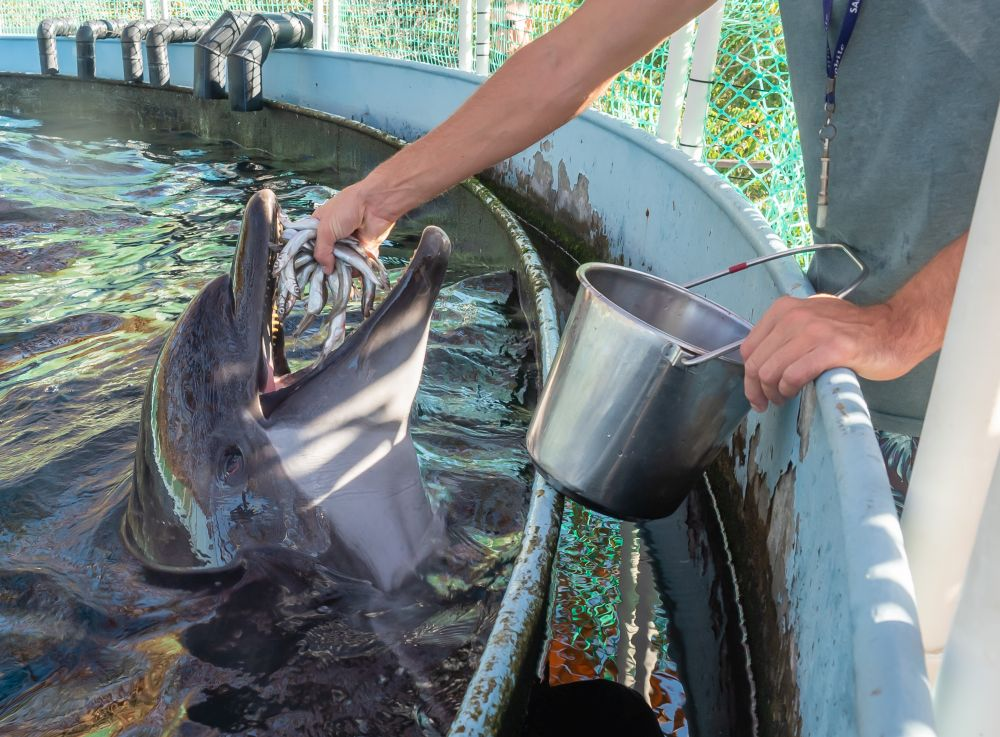
- The idea that they will work for fish when they are hungry is nonsense. If you don't feed a dolphin or underfeed it, it will suffer from thirst. It doesn't drink salt water. It gets fresh water from fish to maintain internal homeostasis. If you don't give it the required amount of fish, it will want to drink while in salt water. This is absolutely forbidden, it is a life-threatening condition. Therefore, there are rules written in the blood of dolphins and people who looked after them: a dolphin must eat a certain amount of fish from the animal's weight, no matter what it does or doesn't do. It uses energy - for breathing, for thermoregulation, for swimming. If you don't feed it, it starts eating itself. Internal catabolism works like this: if it breaks down one gram of fat, it gets four grams of water.
- They say about dolphins that they save people drowning in the sea. Is that true?
- No. They don't care about people. A dolphin uses echolocation to navigate in the sea. It does not need to swim up to you and look at you with a "dolphin's gaze". It receives all the information about who is in front of it from a certain distance: whether it is a relative or not, dangerous or not, edible or inedible. A person is of no interest to it in any way. Unless it is a dolphin that was released or escaped from a dolphinarium. When catching, when placing in artificial conditions, we break the dolphin's instinct to avoid a person. And a dolphin that has lived in captivity, one way or another understands that a person is not a threat to it, but rather positive emotions - fish, some tactile reinforcements.
— If we release a dolphin from captivity into the wild, does it lose its fishing skills?
— No, although all the eco-activists shout about it. They don’t need to be taught this again. 60 million years of evolution are in a dolphin’s head – it won’t forget how to catch fish! If it’s born in captivity, it doesn’t need to watch its mom and dad, grandparents hunt, it already knows.
- The main reason why it’s dangerous to release animals from artificial conditions into the wild is that these animals are not afraid of people. And people are different. Dolphins start to approach people, they are not afraid of nets – they can get tangled. Once, an animal escaped from our dolphinarium. It had been wandering around the Black Sea for a year and a half, and then came to Turkey. The Turks saw that it was clearly not afraid of people, and was approaching people. They notified the Black Sea countries through the Ministry of Foreign Affairs – where had it escaped from? Two weeks later, we caught the beluga whale and brought it here. She was not hurt. More precisely, she was almost hurt: the Turkish side showed us a video of a beluga whale standing with its mouth open, and a can of Coca-Cola, a loaf of bread was thrown into its mouth...
— That’s horrible!
— The human reaction is to feed. If she swallowed this can, in six months the can would have dissolved, injured her stomach - and goodbye. That is why it is dangerous to release them. We "broke" them, and it is very difficult to wean them off people. This is domestication. If you violate the most powerful instinct of fear of people, then these dolphins become uncontrollable in the sea. They can come up to you, let you pet them. But they do not save people.
— What is this myth based on?
— There is a pronounced instinct to preserve the species – if a dolphin is weakened, sick, injured, then the social group around it begins to support it. And people, seeing this from time immemorial, extrapolated this to humans – dolphins save each other, support each other on the surface of the water, which means they can also save people. To date, there is not a single recorded fact of saving a person.
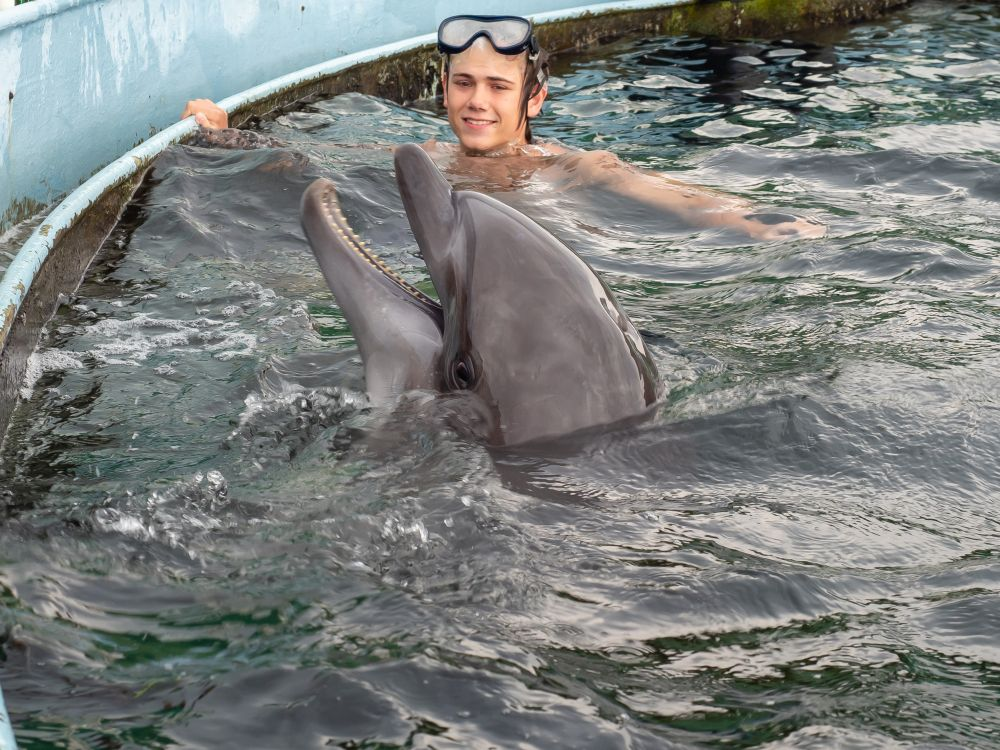
— And cases of attacks on humans, aggressive behavior?
— As many as you like. Usually these are dolphins that have been in captivity. The dolphin is not afraid of humans, it approaches them. How do humans behave? For example, they can hit the eyes of the animal with their nails. So 10 people had a good swim with dolphins in a dolphinarium, 20. And 50 people? If it is not organized correctly, anything can happen. We have experienced these mistakes in our time. During a ride, someone hit their nails where they shouldn't have hit them. The dolphin turns around, pokes you with its snout, and your ribs break, you drown. This happens. Everything should be organized correctly. Animals should be trained. People who pay for this should be insured by the dolphinarium staff. Dolphins that are allowed to provide such a paid service must be absolutely healthy from brucellosis, leptospirosis, herpes, flu, erysipelas - these are all zoonotic diseases that are potentially dangerous to people. And the dolphin "carries" this on itself. And it can slip in the opposite direction - from a person to a dolphin.
- Now there are a lot of dolphinariums. Is this good or bad?
- I think it is bad, because it is impossible to organize correct conditions for keeping animals in each village that would comply with Russian and international rules. In the USSR, there were no standards for keeping marine mammals in captivity, in the Russian Federation they did not exist until 2019, and then the rule No. 1937 was adopted. As a result, dolphinariums began to change, and those who could not change, closed. And now they are being closed because they do not meet the standards. And this is right.
— Why do we need dolphinariums at all?
— Dolphinariums are needed so that the maximum number of people can see these unique animals.
— But in India, for example, they are banned.
— They hold some animals sacred. Everyone knows about cows. But few people know that they also revere dolphins. We don’t have such traditions. Or this question: why kill dolphins for meat? After the war, people here survived by eating dolphin meat. There was nothing else to eat. Thank God, food appeared, the trade was closed, and there is no need to eat dolphins anymore. But we eat cows or pigs, and we have no problems. But the Japanese traditionally eat dolphins and are not going to sign any conventions. I was in Japan, worked with them for many years, and the Japanese came here. They take exactly as much as they need. It is normal for them that canned dolphin meat is sold. Why deprive them of these traditions? There are a lot of dolphins there. Go to our livestock farm – there is blood flowing there too. You can “raise a wave” on this, promote yourself – but is it necessary?
— Another myth about dolphins is that they heal. Sick children and adults should swim with them, and this will help them recover. Is this true?
— It is a psycho-emotional impact, and nothing more. Someone needs to read an interesting book, and they will feel better. Someone needs to feed a squirrel from the palm of their hand, someone needs to give a carrot to a horse. And someone needs to swim with a dolphin. The psychotherapeutic effect is huge. There are a lot of works on this topic. Usually they refer to English literature: people who have had a heart attack lie down and do not get up, and the control group walks in the park and feeds horses carrots. The latter recover much faster.
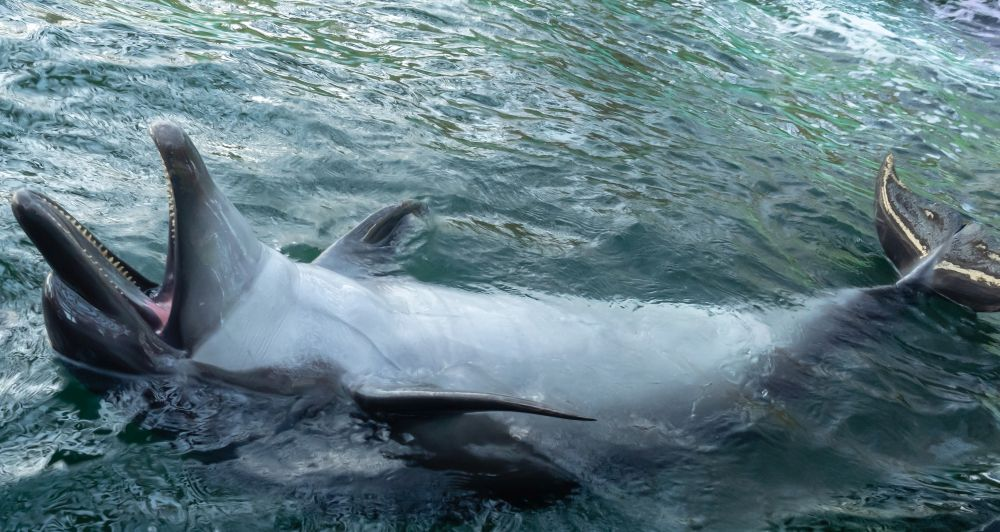
— Exactly. On the other hand, supposedly a dolphin affects a person with its echolocator or biofield, and the person is cured of all diseases. People who say such things, and even take money for it, should be put in prison. Apart from psycho-emotional influence, there is nothing. In the West, they once understood with what intensity and what waves a dolphin emits, they measured them. When you come to a physiotherapy room with a sore knee, they put an electrode on it, turn on one handle - this is the intensity of the current, and a timer - this is the duration of the effect. We will never teach a single dolphin in the world to come up and turn on its locator with a certain intensity and not turn it off for a certain amount of time, so that it emits a certain field with a certain intensity. This is nonsense. The device can do this. That is why physiotherapy heals, but a dolphin does not. It has nothing with which to do it. If we delve into the dolphin, its organs and systems, there is no structure that heals. There is nothing miraculous there.
— Besides, if such “therapeutic” bathing is not organized correctly, it can be dangerous!
— Of course. Just imagine: Moscow, a dolphinarium, everything is beautiful. A young man proposes to his girlfriend, buys her a certificate for swimming. The girl goes into the water, the dolphin takes her for a ride, everything is great. If the organization is incorrect, it happens that the dolphin “plays too much”. He likes it, and he does not let the person out of the water. The trainer, who should be insuring, went off to smoke. The girl swam enough, drank enough water, pulls herself up on the handrail to get out, and then the dolphin bites her leg. Not because he wanted a piece of meat - he wanted to hold her leg, not to let go. But from the side it looks like a bite. He has 44 teeth on the lower and upper jaws. The teeth are sharp, conical. She even jerked her leg. Naturally, a cloud of blood, the proposal was thwarted, a tragedy.
— And there is also a certain number of women who like to give birth in water. Moreover, there is an extra-advanced category of women who believe that they will give birth not just in water, but in the presence of dolphins.
— No way!
— And whatever you say: let them into the territory of the biological station! One with a huge belly, the other two are also pregnant... We had some like that. Their instigator was put in jail, thank God, otherwise it was unbearable. We barely fought them off. But this is not only in Russia! We worked in a different direction in Israel. The 1990s. A colleague comes from the Red Sea, where there is also a dolphinarium, they collaborated on scientific issues with the University of Berlin: "Andrey, we have this story ... Pregnant tourists are coming, they want to give birth here. We do not let them in, but they try to "break" us, insisting that they will give birth in a floating plexiglass aquarium. The aquarium will float, the woman in labor will be inside, with a nurse. And around, behind the plexiglass, our dolphins will swim. What can you say?"
— What can you even say to that! God forbid. But there are also statistics to the contrary. As a result, the Israeli Ministry of Health expelled them from the country at the state level, banned pregnant women from approaching the dolphinarium and giving birth in the water. That's how it happens.
— Dolphins now live longer because they have learned how to keep them properly. But why such captivity, where you live for a long time, because you don't have the main thing - freedom. You can't swim kilometers in the open sea, dive to the depths you are used to...
— It is a profound misconception that dolphins move little in the dolphinarium. This is absolutely wrong. In fact, they hung a "pedometer" on a dolphin in the dolphinarium in Tel Aviv. One wall there was glass. In the summer we demonstrated "red dolphins" from Russia there, and in the winter we did scientific research. We installed a camera and watched the dolphin through the glass for 24 hours. It turned out that inside a pool 25 meters long, 15 meters wide and 5.5 meters deep, he swims from 120 to 180 kilometers.
— Is this normal for them, is it habitual?
— Absolutely. The depth of Taman Bay is 2.5 meters – they give birth and swim, no problem!
— And what about the fact that they are bored in the pool? They are used to constantly changing the environment, swimming long distances.
— Why? They hunt. They follow the fish. You have to look at it differently. They swim not because they are interested – they are looking for fish. The word “interesting” cannot be used here at all.
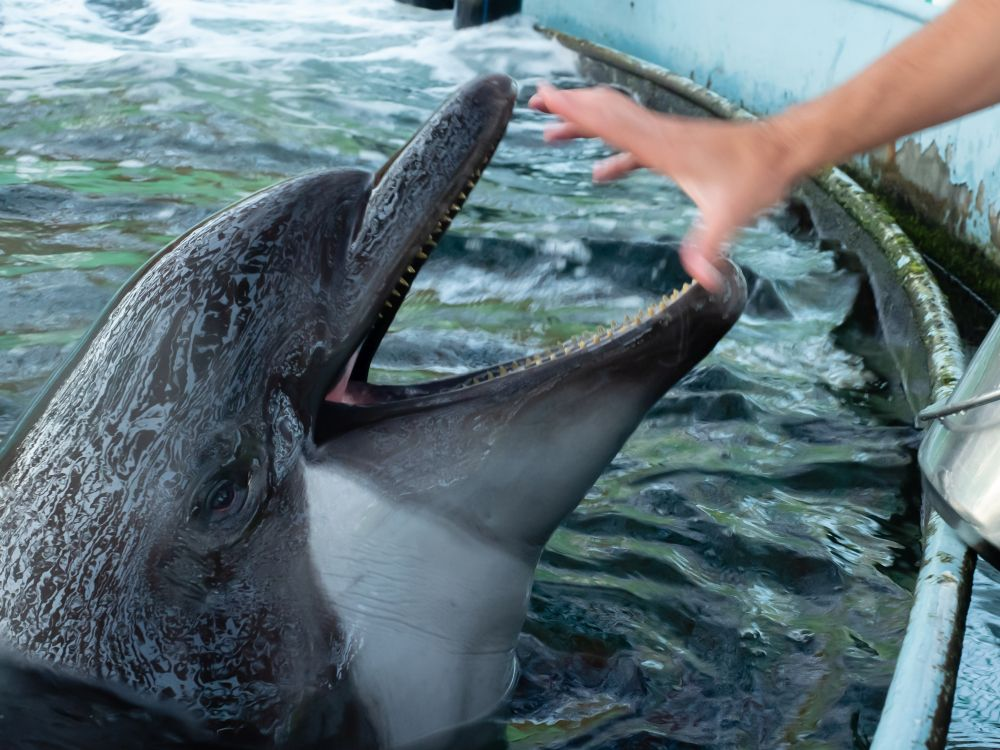
— And what word is appropriate?
— Important, unimportant, motivated, unmotivated. We have tables hanging up – there are pelagic species of dolphins that live in the open sea, at great depths, they need space, swim-swim-swim for a long time. Again – why? They chase schools of the same sardines that go through the ocean, and they follow them. These dolphins do not live well near the shore. They have a very hard time with captivity. That is why we do not keep them. We have tried. People all over the world have tried. It turned out that the most promising species for keeping in captivity are those species that live near the shore, they do not need great depths. They do not dive one and a half kilometers for squid and know what shallow water is – when echolocation signals are reflected both from the bottom and from the surface. They know these obstacles. These dolphins tolerate cramped conditions better than pelagic species. And it turned out that bottlenose dolphins Tursiops truncatus (as they are called all over the world) are the most promising for artificial maintenance.
— What would you like to change at the biological station if such an opportunity presented itself?
— I would probably think about the living conditions for the employees. Normal communication is needed, the Internet. Naturally, we need to improve the conditions for keeping animals, if we say that we need to keep dolphins all year round to carry out certain work.
— For example, we started artificial insemination of dolphins. There was such an intention - to turn the Utrish marine station into a maternity hospital for dolphins. We did not only because it is expensive. You have dolphins, on whose maintenance a huge amount of money is spent, and they do not bring in income. Well, you wrote an article, well, your babies were born. If you haven't registered these babies with a government permit, haven't taken them away, haven't sold them to China or Germany, you haven't covered all your expenses. You need a water intake for the dolphins, a sewer system for people. You need a lot of things.
— What feelings do you have for dolphins after 40 years of working with them?
— The same as in the beginning. Reverence and care. They still appear in your dreams at night, you worry about them as if they were your own children. Everything is the same, if you think about something at night, you can’t fall asleep. It’s impossible to get used to it. If we lose them, it’s a tragedy.
— Are they individuals for you?
— From a professional point of view, it is believed that they should all be the same. But it doesn’t work out that way. They all have a distinct character – except for their appearance and habits. The longer you work with a particular dolphin, the more attached you become.
— Do you have any favorites?
— That shouldn’t be the case. I work with all of them, and the animals you see here, except for one small male born in captivity, were all caught by me in Taman. They have Taman roots. The trainers Anton and Kirill, the senior trainer Oleg and the veterinarian Olga are working with them now. I don't have direct contact with them, although I love them. But I don't want to single out any of them.
— Another unprofessional question: do they hold a grudge against you for catching them?
— Resentment, holding a grudge are anthropomorphisms. They don’t know that they were caught. They experience the deepest stress of captivity due to a powerful release of cortisol, the main stress hormone. Some may even die because of this. Some endure. For some, we stop this condition using a special attitude and certain chemistry. That’s all. We bring them in – and quickly start “blowing the dust off them”. Don’t say, “You destroyed families, half of them stayed in Taman! They’re crying!” I caught and will continue to catch, God willing, because we do it right. Gently. How to choose a group, how to approach the sea, how to look – are there pregnant females, are there any babies from last year, do you need such animals… And only then do you make a decision. But, as a rule, you turn around and leave. The next dolphins come – you look again. Deciding on your own is a huge responsibility.
— Why is it important to study dolphins from a scientific point of view? What is the gain?
— A person is a person because he wants to know everything. This is fundamental knowledge. And from a practical point of view, for example, studying the mechanisms of sleep gives us an important way to treat its disorders. There are many sleep disorders. And dolphins do not have a "sleep-wakefulness" cycle, like us. People have huge problems with insomnia, from lack of sleep, mental disorders are associated with this. But a dolphin can sleep for two seconds with one hemisphere of the brain, and a few hours later sleep for three seconds with the other - and that's it. It does not have a "night-day" cycle, it does not need it at all.
— Perhaps we will learn to use this somehow. At the moment, it is good that we have studied how they sleep. Maybe someday this will give us a breakthrough. And I am sure there are a whole sea of such opportunities.
